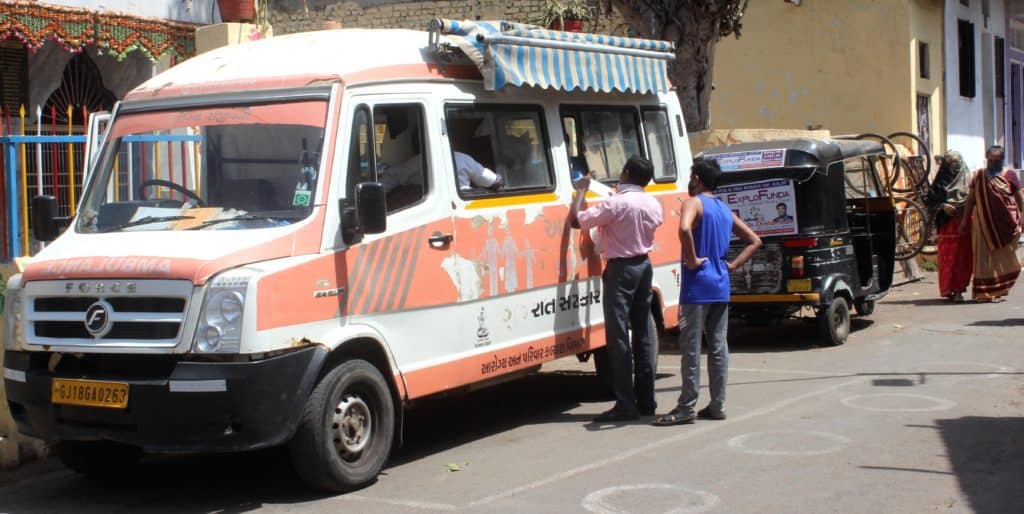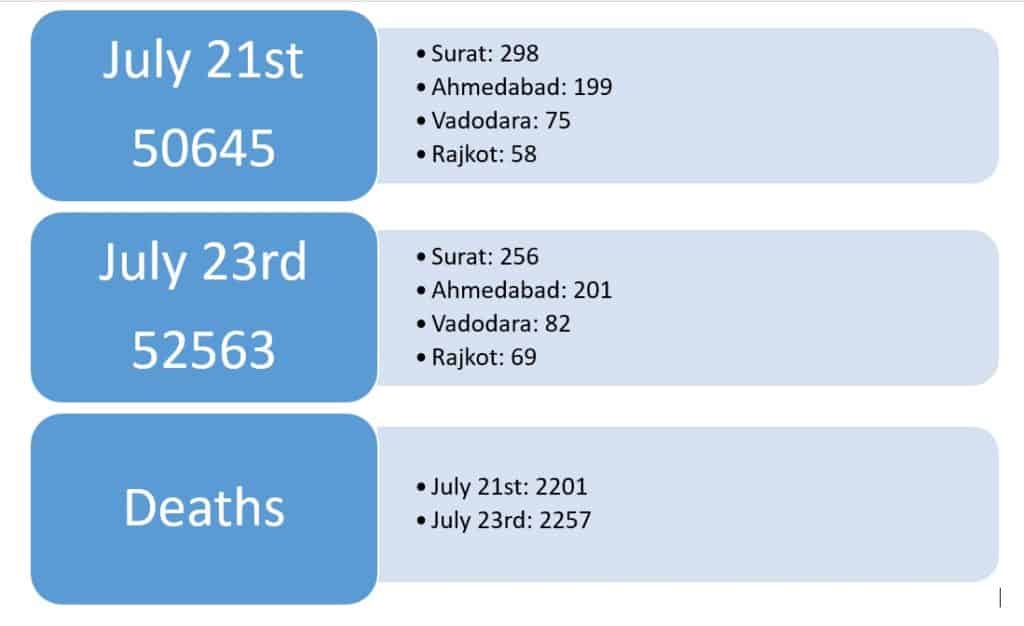They came. They saw. They left. The Central team that visited Gujarat on July 17-18th to assess the state’s response to the continuing surge in COVID-19 cases in Ahmedabad and Surat did just that, even as the Ahmedabad Medical Association (AMA), on July 17th, filed an SOS writ petition in the Gujarat High Court. The petition expressed serious concern over the low number of tests being conducted and on the state’s dilly-dallying on granting approval for more testing laboratories.
The AMA also sought a direction that tests at the OPD level should be permitted. It was only on July 15th, two days prior to the Central team’s visit, that the government had approved another AMA plea, the subject of an earlier High Court petition, to allow MBBS degree holders to prescribe a COVID test.
The Central team, comprising AIIMS Director Dr Randeep Guleria, Director-General of Indian Council of Medical Research Balram Bhargava, Additional Secretary to Union Health Ministry Aarti Ahuja and NITI Aayog member VK Paul, found merit in two of the state government’s initiatives: one of them being the Dhanvantri raths, medical vans that visit various housing societies in Ahmedabad and Surat testing asymptomatic individuals and distributing Ayurvedic potions.
The other is the Ahmedabad Municipal Corporation’s strategy of drawing up micro-containment zones in select housing societies, flats or residential clusters within various localities.

Reluctance to test
The team remained silent, however, on the reluctance of the state government to ramp up testing, despite the Gujarat chapter of the Indian Medical Association making an urgent representation to the Central team during discussions on the State’s latest corona hotspot Surat. Besides inadequate testing, the association also pointed to the desperate need for providing more beds and supply of necessary drugs.
It may not be a coincidence that the State Government, for the first time since the first two corona cases were reported on March 19th, conducted over 10,000 tests per day just 48 hours before Dr Guleria and others landed in Ahmedabad, which accounts for about 50 per cent of total cases. This happened again on July 19th, when 12,323 samples were tested during the previous 24 hours.
Number of tests
- July 19th: 12,323
- July 21st: 13,693
- July 22nd: 14,024
- July 23rd: 15,417
Prior to that, the maximum tests per day conducted in Gujarat till the second week of July was 9,000-plus. Before that it was doing about 6,000 tests daily, even as experts warned that the state was witnessing community spread with newer areas being affected daily.
As the central team departed for Delhi, Gujarat reported a significant surge in cases. During the 24 hours as on July 21st, Gujarat had 50,465 cases with the death toll at 2,201. On July 23rd, the state had 52,563 cases and a death toll of 2,257.

The State was averaging more than 1,000 cases per day for the first time during this period. The virus has now spread to 32 out of the state’s 33 districts — barring the small tribal district of Dangs.
The more alarming subtext of this spread is the emergence of new hotspots like Rajkot, Bhavnagar, Mehsana and Bharuch, to which little attention is being given. This spread happened after the lifting of lockdown with most patients in these towns having a travel history to Ahmedabad, Surat and Vadodara.
Court of last resort
In its July 17th petition, one of half a dozen other petitions relating to COVID pending before the court, AMA’s doctors warned that the damage caused by the virus could become irreversible unless aggressive sampling and testing is started immediately.

The Gujarat government has claimed that it is conducting an average of 7,000 to 8,000 tests as per ICMR guidelines.
“It is crucial to recognise that this is the second spike after a relative lull,” says Dr Mona Desai, President of the Ahmedabad Medical Association, emphasising the need for “frenetic pace of testing, contact-tracing and isolating affected people.”
Reeling out numbers stated in her petition, Dr Desai told us that the State was not testing adequate number of people commensurate with its 6.27 crore population.
She pointed out that Tamil Nadu (Population: 6.79 crore) was doing 35,000 tests daily, New Delhi (Population: 1.9 crore) tested 23,000 samples every day and Maharashtra (Population: 11.42 crore) was doing 30,000 tests daily.
“Look at Dharavi, the world’s largest and most thickly populated slum,” said Dr Desai. “Maharashtra has brought the situation under control, just by testing, contact tracing and isolating people. This is the only way.”
Meanwhile, Gujarat’s Covid-19 mortality rate at 4.5% continued to be higher than the national average of 2.5%.
The association had to move the high court to get even the most basic protocol measures implemented. “We first request the government orally and with written representations. When nothing moves, we are left with no other option,” says Dr Desai.
Curiously, the State Government told the Gujarat High Court on July 23rd that the RT-PCR tests were “not 100% accurate and only 70% trustworthy” and so handing out negative reports to people would make them complacent about the seriousness of the situation. Besides, it claimed that it was conducting an average of 7,000 to 8,000 tests as per ICMR guidelines.
“The situation is very serious in Surat, we told the Central team about this,” says Dr Chandresh Jardosh, president of the Gujarat unit of IMA. Dr Jardosh told us that while Surat is testing hardly 300 samples a day, there is on the other hand a severe shortage of doctors, nurses, ward boys to cope with the rising number of patients. The government has had to call MBBS students as assistants. Several doctors, nurses and other staff have quit their jobs after several of them tested positive.
Voluntary lockdown
Dr Jardosh attributes the sudden surge in cases in Surat to “the people’s casual attitude as well as the government’s lack of preparedness”. The spurt in Surat started from the overcrowded diamond markets and tiny units where social distancing is simply not possible, as well as from the hundreds of thickly-populated textile markets. Now all of them have voluntarily downed shutters till July 31st.
“Tests, tests and tests — though the number of cases may look bigger doing this, it will help in checking the further spread of the virus,” insists Dr Jardosh. He observes that the spike has made people more serious about taking precautions. They are implementing self-lockdown without waiting for the government, while the latter, in the doctor’s words, “seems to be on its own trip.”
As for laboratories, though Gujarat has 41 labs for testing (23 government and 18 private, as per the ICMR website), 19 of the 33 districts do not have any testing facility as the ICMR approved labs there are awaiting state government approvals.
“The government takes its own sweet time in giving approvals, clearly because it is hesitant to go for aggressive testing,” said a senior pathologist, pleading anonymity since his lab is awaiting government permission.
Again, it is perhaps not a coincidence that of the five private labs in Surat, two got state government approvals on July 16th, a day ahead of the Central team’s arrival, even though ICMR permission for it had been acquired two months ago.